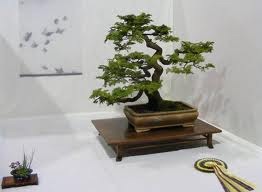 Wiring is the practice of wrapping aluminum or copper wire around the bonsai trunk or branches to shape the tree. Training bonsai is never easy, but it can be made easier by proper preparation and execution. Here are some basic guidelines.
Wiring is the practice of wrapping aluminum or copper wire around the bonsai trunk or branches to shape the tree. Training bonsai is never easy, but it can be made easier by proper preparation and execution. Here are some basic guidelines.
Wire
The first step is to select the appropriate wire for the job. Aluminum (Al) and copper (Cu) are the two most common choices, with copper considered more attractive for the long bonsai training period. Use annealed copper only. Never use steel wire to wrap a bonsai, it is toxic to several species.
In order for the wire to shape the tree, small stresses must be placed at various points along the length of the trunk or branch. This means the wire has to be stiffer than the trunk or branch. Otherwise, the wire bends rather than the tree.
Thicker wire is generally stiffer. Aluminum is easier to bend, hence easier for novices to apply. Copper is generally stiffer, but more prone to scarring the tree if applied incorrectly. A good starting point is wire 1/3 the thickness of the branch that will be shaped.
Practice wrapping on a tree branch of similar species to develop the dexterity needed. Test different thicknesses on test branches from a similar size and species before using any on the tree to be trained. Several different thicknesses will be required to do the entire tree – practice with all of them. Start with 1mm and work your way up to 4mm.
Application
Wrap from the base of the trunk upward, thicker branches next, smallest branches last. When wrapping a branch, start at the base and wrap toward the tip.
Bend gently into shape, listening for cracking. If you hear any, stop immediately and check for damage. Repair with tree paste or glue and do not work again with that branch for at least a year.
Use a wire length about 1/3 longer than the trunk or branch and wrap slowly in a spiral motion around the trunk or branch. Apply firmly, but not too tightly. You don’t want to have the bark grow around the wire, resulting in scarring.
Wiring is often done on deciduous trees in late autumn, after the leaves have fallen. This creates a more visible work area. If you choose to wire in summer, as is done with conifers for example, be sure to avoid wrapping wire on top of needles.
It is considered bad form for any wires to cross. There’s no physically necessary reason for this, other than some small additional stress on the branch at the point they cross. These points can be the most likely to scar. However, the Japanese and Chinese art of training bonsai is very traditional and respecting it is worth serious consideration.
After wrapping is completed, observe the tree closely over time to watch for a wire that begins to cut into a branch. If you see this about to happen, cut off – don’t unwrap – the wire carefully using wire cutters that can snip at the tip.
When the training period is complete, after a few months, again cut, don’t unwrap, the wire. To save a few pennies of wire, you are risking cracking a branch that make take years to heal. Cracking a trunk will most likely lead to the death of the tree.
Wrapping properly is a delicate skill, requiring patience to master. But it is within reach of any dedicated practitioner, and the results are well worth the effort.

Deprecated: strpos(): Passing null to parameter #1 ($haystack) of type string is deprecated in /home/agriviek8Qv/agriviet.net/public_html/wp-includes/comment-template.php on line 2522